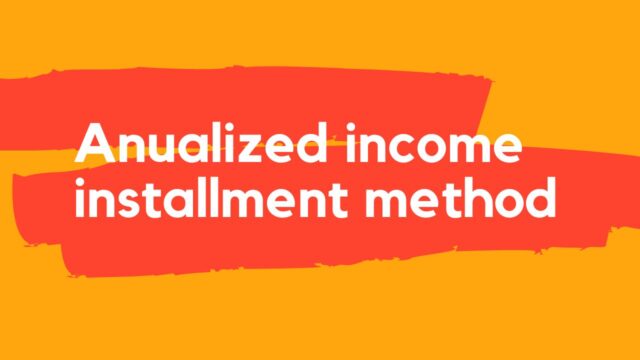
Annualized Income Installment Method Exceptions
The annualized income installment method allows taxpayers to pay their tax bill in four equal installments of 25% of their taxable income. This method is especially useful for people with irregular income, as it allows them to reduce payments for low income and increase them for high income. To understand how this method works, it’s important to know the basic rules of it. However, there are some exceptions to its general rules. Read on to discover more about these exceptions.
Exceptions to the annualized income installment method
In order to minimize underpayment on estimated tax payments, self-employed taxpayers should opt for the annualized income installment method. This method calculates estimated tax installment payments based on known information. In addition, it helps limit underpayment penalties by estimating tax payments based on income. Typically, self-employed taxpayers must pay quarterly estimated taxes. These payments must be paid in four equal installments. If your income fluctuates from quarter to quarter, the annualized income installment method is the best way to go.
There are certain exceptions to the annualized income installment method. The first exception applies to large corporations, which must add the reduction from their first estimated tax installment to their second installment. However, the annualized seasonal income method is not applicable to third and fourth installments. Using the annualized income installment method on these installments can help them avoid underpayment penalties. Using the annualized income method, these taxpayers may have a lower tax burden for the following year.
Exceptions to the annualized income installment methods allow taxpayers to make estimated payments throughout the year. For example, if a taxpayer paid $5,000 in April, the practitioner must apply exception 1 to the payment for the second quarter. This means that a taxpayer must make an estimated payment of $27,100 for the third quarter, compared to $55,000 for the second quarter. Using an annualized income installment method allows taxpayers to pay only 110% of their total tax liability during the prior year.
Exceptions to the safe harbor for depreciation expenses
Exceptions to the safe harbor for devaluation expenses include amounts paid for inventory and amounts paid for land. These expenses are not deductible as depreciation expenses, and may be deductible as a business expense instead. The safe harbor is a special rule that allows taxpayers to use a higher threshold if it clearly reflects their income. Typically, taxpayers elect to capitalize and depreciate property when it exceeds a certain threshold.
For businesses that generate less than $10 million in annual revenue, repairs and maintenance are deductible immediately. However, to qualify for this exception, the business must meet specific criteria. It must be a routine activity that results in the normal wear and tear of business use. Additionally, the repairs and maintenance must be necessary to keep the property functioning at its optimum level. Finally, the repairs must be a normal part of the business’ operations.
In addition to the safe harbor for depreciation, taxpayers should consider the de minimis exceptions for expensing amounts paid for tangible property. In general, a taxpayer may expense up to $5,000 per invoice, or $2,500 per unit, provided that it possesses the appropriate financial statements. However, the threshold has increased to $2,500 as of Notice 2015-82. It is also important to note that the safe harbor for depreciation expenses has been extended to businesses that invest in non-asset-generating tangible property.
Exceptions to the general rule for calculating payments
In many cases, the taxpayer can use the year-to-year method to determine annualized income installment payments. If the taxpayer does not use the annualization method, the installment payment required in the third quarter would be higher than in the second quarter. For example, if a taxpayer had a taxable year of 52 weeks but only nine months, he would make payments of $55,000 in the third quarter. But if the taxpayer uses the annualization method, he would have a payment of $7,100 in the fourth quarter.


































